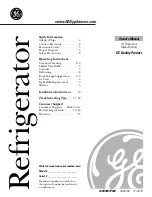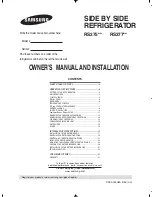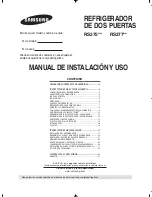
Freezing food/Storing frozen food
Page EN-20
• Combine the drawers as shown in the di-
agram on page EN-11 to achieve the most
efficient use of energy for your appliance.
Preparing food
• Only freeze high quality food.
• Freeze fresh and prepared food dry and
unseasoned. Unsalted foods are more du-
rable.
• Allow prepared food to cool before freez-
ing. This not only saves power, but also
prevents excessive frost formation in the
freezer.
• Carbonated drinks are not suitable for
freezing because the carbon dioxide es-
capes during freezing.
Suitable packaging
Packaging is important when freezing. This
will protect against oxidation, penetration by
microbes, transfer of odours and flavourings
and drying out (freezer burn).
• Only use packaging material that is strong,
impermeable to air and liquid, not too stiff
and labelled. It should be designated as
suitable for freezer use.
• Use plastic clips, rubber bands or adhesive
tapes to seal.
Portions
• Use flat portions as much as possible;
these freeze through to the core faster.
• Expel the air from the freezer bag as this
causes the contents to dry out and takes
up space.
• Fill liquid containers no more ¾ full, be-
cause liquids expand when frozen.
• Do not store glass or metal containers con-
taining liquids such as water, lemonade,
beer, etc. Water expands when frozen and
may burst the container.
Only high percentage alcohol (from 40%
volume) should be frozen; make sure that
it is tightly sealed.
• Label the frozen food by type, quantity,
amount and expiry date. Use waterproof
marker pens or adhesive labels wherever
possible.
How to pack the freezer properly
Freeze smaller quantities
Once the freezer temperature is –18 °C, you
can freeze fresh, room-temperature foods.
Freezing capacity
You can find information concerning the
freezing capacity of your appliance on the
type plate of your appliance.
• Adhere to the maximum freezing capacity
wherever possible.
Up to the maximum indicated freezing
capacity:
If you adhere to the maximum freezing ca-
pacity, the goods will freeze the quickest. The
temperature in the freezer briefly rises after
placing fresh goods inside. After 12 hours, the
goods are frozen to the core.
Above the maximum indicated freezing
capacity:
If you want to freeze more food in one go as
an exception, freezing will take longer. Keep
fresh goods out of contact with existing fro-
zen foods, as the frozen foods could start
to defrost. If contact with stored food cannot
be avoided, we recommend that you create
a cold reserve in the freezer before freezing
the fresh goods.















































